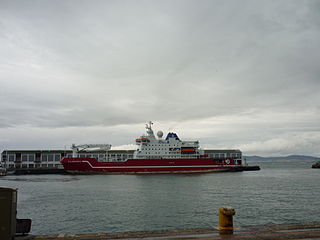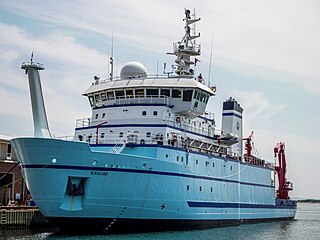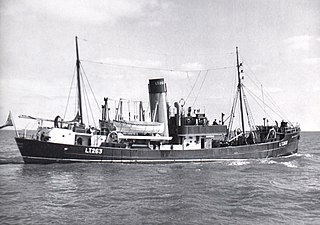
Namibia follows a largely independent foreign policy, with strong affiliations with states that aided the independence struggle, including Libya and Cuba.

The Ministry of Foreign Affairs is an executive department of the Government of Japan, and is responsible for the country's foreign policy and international relations.

The Rauma-class missile boats are a class of missile boat in use by the Finnish Navy.

Mir is a self-propelled deep-submergence vehicle. The project was initially developed by the USSR Academy of Sciences along with Design Bureau Lazurith. Later two vehicles were ordered from Finland. The Mir-1 and Mir-2, delivered in 1987, were designed and built by the Finnish company Rauma-Repola's Oceanics subsidiary. The project was carried out under the supervision of constructors and engineers of the Shirshov Institute of Oceanology.
The Centre for Environment, Fisheries and Aquaculture Science (Cefas) is an executive agency of the United Kingdom government Department for Environment, Food and Rural Affairs (Defra). It carries out a wide range of research, advisory, consultancy, monitoring and training activities for a large number of customers around the world.

Vessel Monitoring Systems (VMS) is a general term to describe systems that are used in commercial fishing to allow environmental and fisheries regulatory organizations to track and monitor the activities of fishing vessels. They are a key part of monitoring control and surveillance (MCS) programs at national and international levels. VMS may be used to monitor vessels in the territorial waters of a country or a subdivision of a country, or in the Exclusive Economic Zones (EEZ) that extend 200 nautical miles (370.4 km) from the coasts of many countries. VMS systems are used to improve the management and sustainability of the marine environment, through ensuring proper fishing practices and the prevention of illegal fishing, and thus protect and enhance the livelihoods of fishermen.

Finland–Namibia relations refers to the bilateral relationship of Finland and Namibia. Finland recognised Namibia on March 21, 1990. Both countries established diplomatic relations on the same day. Namibia has an embassy in Helsinki while Finland has an embassy in Windhoek and an honorary consulate in Walvis Bay.

STX Finland Oy, formerly Aker Yards Oy, was a Finnish shipbuilding company operating three shipyards in Finland, in Turku, Helsinki and Rauma, employing some 2,500 people. It was part of STX Europe, a group of international shipbuilding companies owned by the South Korean STX Corporation.

The Government of Namibia consists of the executive, the legislative and the judiciary branches. The Cabinet is the executive organ of government, implementing the laws of the country. It consists of the President, the Prime Minister and his deputy, as well as the Ministers. The legislative organs of government are the National Council and the National Assembly. They make the laws of the country. The judiciary organs of government are the courts. The highest court of Namibia is the Supreme Court. There is also the High Court, and lower courts.

S. A. Agulhas II is a South African icebreaking polar supply and research ship owned by the Department of Environmental Affairs (DEA). She was built in 2012 by STX Finland Rauma shipyard in Rauma, Finland, to replace the ageing S. A. Agulhas, which was retired from Antarctic service in April 2012. Unlike her predecessor, S. A. Agulhas II was designed from the beginning to carry out both scientific research and supply South African research stations in the Antarctic.

RV Tangaroa is a research vessel operated by the New Zealand National Institute of Water and Atmospheric Research. It was purpose-built as a Deepwater Research Vessel for the then Ministry of Agriculture and Fisheries Research Centre at a cost of $27 million to replace the ageing GRV James Cook. It has a DNV classification of 1A1 and Ice 1C. It was transferred to the new National Institute of Water and Atmospheric Research in 1992.

RVSikuliaq is an American research vessel owned by the National Science Foundation and operated by the University of Alaska Fairbanks College of Fisheries and Ocean Sciences. Built in 2014 by Marinette Marine Corporation in Marinette, Wisconsin, the $200 million vessel replaced the 1966-built research vessel Alpha Helix that was retired in 2007. Sikuliaq, named after the Iñupiaq word for "young sea ice" and pronounced "see-KOO-lee-auk", will be homeported in Seward, Alaska.

Turva is a Finnish offshore patrol vessel. Built in 2014 by STX Finland Rauma shipyard for the Finnish Border Guard, she is the largest vessel of the fleet as well as the first patrol vessel in Finland powered by liquefied natural gas (LNG).
Rauma shipyard is a shipyard in Rauma, Finland. It was previously operated by STX Finland which is owned by the South Korean STX Corporation. Rauma shipyard is specialized in large ferries, small cruise ships, multipurpose icebreakers and small naval craft.

The RV Bilim-2 is a Turkish research vessel owned by the Middle East Technical University in Ankara and operated in deep waters by its Institute of Marine Sciences based in Erdemli, Mersin, Turkey.

Rauma Marine Constructions (RMC) is a Finnish shipbuilding company based in Rauma, Finland. The company's main products are car ferries, icebreakers and naval vessels.

RV Sir Lancelot (LT263) was a fisheries research vessel that was operated by the Directorate of Fisheries, now known as the Centre for Environment, Fisheries and Aquaculture Science (Cefas).

RV George Bligh (LO309) was a fisheries research vessel that was operated by the Directorate of Fisheries, now known as the Centre for Environment, Fisheries and Aquaculture Science (Cefas).

RV Clione (LT421) was a fisheries research vessel that was operated by the Ministry of Agriculture, Fisheries and Food - Directorate of Fisheries, now known as the Centre for Environment, Fisheries and Aquaculture Science (Cefas) between 1961 and 1988.

Namibia–Spain relations are the bilateral and diplomatic relations between these two countries. Namibia is accredited to Spain from its embassy in Paris, France. Spain has an embassy in Windhoek.
















